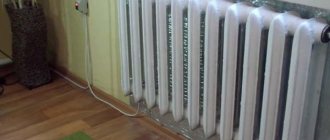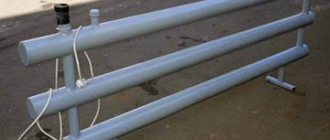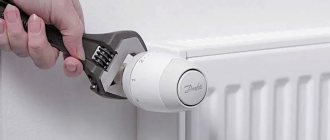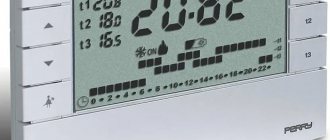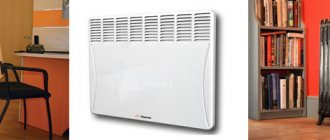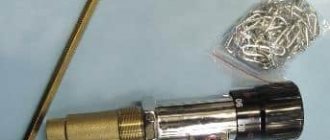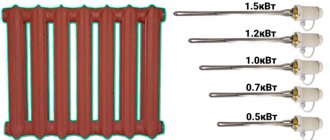The importance of a device designed to regulate and/or shut off the flow of coolant in a radiator cannot be overestimated. First of all, this is a matter of convenience - this way you can regulate the degree of heating. Secondly, and no less important, is the issue of safety. If there is a valve, in an emergency you can simply disconnect the battery from the riser. It must be said that this is not provided for in old heating systems, and even in some new ones. That's why owners install shut-off and control devices - this can be a cone valve, a ball valve or an automatic thermostat. The ball valve is not very good because it works exclusively on “open-close”. It is better not to place it in an intermediate position; this leads to wear of the ball itself and, as a result, loss of tightness. The valve is preferable in this regard, but there is also a lot of hassle with it - remember to open it, remember to close it, and return it to the position in which it was originally... It’s easier to entrust the work to automation.
Content
An automatic thermostat for a heating radiator is a thermostatic valve that, without additional human effort, regulates the degree of heating of the room over a fairly large temperature range. It lowers it if it’s warm and sunny outside and gradually raises it when the outside temperature drops.
The design of the thermostat for the heating radiator depends on the type of heating system. There are two of them:
- single-pipe;
- two-pipe.
Thermostats, in turn, come in two types: electronic and mechanical.
An electronic thermostat for a heating radiator is an automatic device that regulates the temperature in various heating systems. It is equipped with a temperature sensor, built-in or remote. The latter is installed in an area inaccessible to direct influence of thermal installations. Electronic thermostats are divided into digital and analog. The first ones are the most popular.
Electronic thermostat for heating radiator
Digital regulators, in turn, are divided into:
- with closed logic.
- with open logic.
The first option is distinguished by a rigid, well-functioning system that operates without external changes. Only a number of programmable parameters can be changed.
The second option involves an abundance of customizable parameters and functions; everything can be changed, configured and programmed here, to suit any environmental conditions. It should be noted, however, that handling open logic devices is more difficult - a fairly high level of knowledge is required, which is more typical for an industry worker than for an ordinary person. Using a thermostat will require significant effort precisely due to the lack of special knowledge.
Now about the mechanical ones. Simply put, the mechanism is a valve and a thermal head connected to each other. The latter includes:
- liquid element (in some cases elastic or gas);
- drive unit;
- regulator
A mechanical thermostat consists of the following elements : a thermal cylinder with a corrugated inner surface (or bellows); thermal valve; sensitive element; scales; compensatory mechanism; union nut; fixing ring; connector; transmitting rod and spool valve.
The secret of operation is that in an automatic thermostat the valve is in contact with the thermal head - an element that is sensitive to any changes in temperature in the room, even minor ones.
If it gets colder, the contents of the thermal cylinder narrow, the valve stem retracts - thus, the coolant flow increases, and accordingly, the temperature in the home also increases. If the room, on the contrary, is too hot, the contents of the can will expand, and accordingly, the heat transfer from the radiator becomes less.
Mechanical thermostat device for heating radiators
Advantages of modern models
Modern thermostats are surprisingly easy to use, ergonomic, and beautiful in design, which goes with the theme of any interior. That's why more and more homeowners are choosing to install them:
- you can forget about the debate “Open the window, it’s hot!” and “close it, we’ll freeze!” — the thermostat detects even slight changes in temperature outside the window. Thanks to this, the optimal temperature in the room is maintained.
- Easy to install.
- Wide temperature range - usually from five to twenty-seven degrees Celsius.
- The regulator evenly distributes the coolant throughout the “depths” of the heating system.
- Fuel economy (up to twenty-five percent).
- There is no risk that the indoor air will overheat, for example due to exposure to direct sunlight.
Gas-filled or liquid?
Automatic thermal valves are divided into liquid and gas-filled. Gas has undeniable advantages over liquid:
- firstly, gas is more sensitive to temperature fluctuations indoors.
- secondly, the gas condenses in a part located away from the valve body. Accordingly, the reaction speed of such a thermostat is much higher, because the principle of its operation does not depend on the water temperature.
Gas-filled thermostat for radiators
The advantage of a liquid valve is that it transmits data to the mechanism faster, due to a better response to changes in the pressure of the working medium in the corrugated cylinder.
Nowadays, the thermostat for Danfoss heating radiators is very popular. Why is it and why is it better than others? The Danish company Danfoss offers homeowners easy-to-use and reliable thermostats. They are suitable for both old-style and new heating systems. The temperature regulator for the Danfoss heating radiator is also good because it is designed taking into account Russian realities; it does not require preventive maintenance and is durable.
Also on the Russian market, fittings for heating appliances from the German company Oventrop are very popular. Oventrop heating radiator thermostats are also distinguished by high quality, reliability, and reasonable prices allow you to choose pickily.
Whatever brand the thermostats for the heating radiator are, the instructions are where you start handling them. Both installation and operation require compliance with certain rules.
Liquid thermostat for radiators
Installation always begins by turning off the supply riser and draining the water from the heating system. Then the pipeline and valve are cut off and unhooked from the radiator. The shut-off valve and thermostat valve are freed from shanks and nuts. The next step is the installation of the piping and installation of the latter in the right place. Next, the horizontal supply pipes coming from the riser are connected to it.
To summarize, we can say that the most effective thermostat for a heating radiator will be in the room where temperature changes are most noticeable, as well as in individual heating systems.
What are the features of thermostats for heating radiators (video):
In this video you will learn about the advantages and disadvantages of thermostats for radiators.
A properly equipped heating system includes not only a set of shut-off valves for shutting off radiators during repairs or replacement, but also thermostats that allow you to obtain a comfortable temperature in each room. In addition, the use of a thermostat makes it possible to save energy by reducing the amount of coolant entering the battery. In the retail chain you can find several types of thermostats designed for various heating systems. Recommendations from specialists will help you make the right choice and install the equipment correctly.
We save heat: who benefits from batteries with a thermostat?
Smart thermostats will lower the temperature while you are at work and “warm up the temperature” before you return. What can you do with batteries to get additional savings?
Why are “regulated” batteries needed?
Anyone who has been to Europe has seen this “fantasy” with their own eyes: each battery has a temperature controller and a counter for gigacalories “eaten.” It's really convenient. If the room is hot, you simply “screw on” the battery and save on heat. If it’s cold, on the contrary, I set it up in Tashkent in the nursery. I flew away to spend the winter in warmer climes - I turned off all the batteries and didn’t pay a penny for heat. What about us? Does it make sense to invest in heat regulators and meters? Who will they help save?
Temperature regulators: how they work
The battery temperature depends not only on the temperature of the coolant, but also on its speed. The more hot water rushes through your radiator in a second, the hotter it will become.
Just this speed can be changed using regulators, letting less coolant into the radiator. What kind of radiator regulators can you find on the market?
Ball valve
. A simple device that makes it possible to shut off the flow of coolant. This is a crude manual control, locking mechanism that will help reduce the temperature in the room.
Example: HLV ball valve made of brass with a nominal pressure of 10 bar for smooth water supply to the radiator. Has 2 positions: open and closed. There is a connection for a thermal head. Price – from 132 UAH.
Thermostats.
Can be manual or automatic. Consists of a thermostatic head and valve. The difference in control - automatic or manual - depends on the thermal head.
Regular is the most common option. The required temperature is set manually. Such thermal heads can be equipped with a remote, external temperature sensor. These subtypes are used in special cases when it is inappropriate to install the sensor close to the battery - for example, there is another heat source nearby.
Example: Thermal head VT.3000.0.0 allows you to adjust the air temperature from +6.5 to 27.5 degrees. It is attached to the valve using a union nut and screwed onto the thread. Price – from 125 UAH.
Example: FADO TG11 thermal head with remote sensor. Allows you to move the sensor to a more convenient location for temperature measurements. Screws onto the radiator valve. Price – from 560 UAH.
Programmable thermal head. It is enough to set the desired temperature once and the thermostat will then do all the work for you. You can program the temperature. For example, after you leave for work it decreases, and when you return home it is warm again. This way you can save up to 50% of heat. Moreover, you can control it using a smartphone.
Such regulators require power supply: from a battery or from the mains.
Example: The Danfoss Eco thermal head allows you to control the battery temperature programmatically. With its help, parameters can be set via a smartphone using Bluetooth technology. Price – from 1734 UAH.
Pros of thermostats:
- Temperature adjustment: from +5 to +27 degrees.
- Comfort. The adjustment accuracy is up to +1 degree.
- Together with heat meters they provide significant savings.
- Electronic models can become part of the “smart home” system.
Thermostats: when is it beneficial?
Purchasing smart devices for your batteries will not always pay off. After all, for a two-room apartment you need to purchase at least 3-4 devices. When is this appropriate?
- You have a large cottage and use 1-2 rooms. To prevent it from getting too hot on all three floors, turn up the temperature in unused rooms.
- You have a heat meter in your apartment. It makes sense to turn up the heating and save money.
- You live in a multi-storey building with a heat meter and it is warm. The facade of the entire building or your apartment is insulated. Sometimes you open all the doors and windows because it’s hot.
When “the game is not worth the candle”:
- It’s already cold in your apartment: there’s no point in reducing the temperature.
- All rooms in your house are approximately equally warm. You regulate the microclimate by increasing or decreasing the temperature of the coolant.
Nuances of use
The topic of heat regulation is quite extensive and there are many pitfalls in it. Let us highlight some of the features of using thermal heads and taps.
- The thermostat does not affect the coolant temperature. If the batteries barely heat, the smartest thermostat will not be able to heat the water in the battery and do you well.
- If you are changing batteries, you may want to immediately consider purchasing a thermostat. Many manufacturers offer them “paired” with a radiator.
- Do not hide an electronic thermostat with a sensor behind heavy curtains. The sensor will read the temperature near itself, and it will be higher than the average in the room. That is, the readings will be incorrect. If you don’t want to give up your favorite curtains, choose a thermal head with a remote sensor.
- If there are several radiators in the room, there is no point in installing a thermostat on each one. It is enough to install it on 1-2 radiators to reduce the temperature if necessary.
- Do you have cast iron batteries? Please note that they take a long time to cool down and heat up slowly. Fine adjustments by automation will not help them. If you want automation, get rid of your cast iron. Choose: aluminum, steel, bimetal.
- Call a specialist to install the radiator valve. After all, the process is labor-intensive: you need to drain the water from the radiator, cut in a piece of pipeline to install the valve there.
- It’s easy to install the thermal head yourself: the main thing is to choose a model with a suitable thread. Insert into slots and snap into place.
It is convenient to select and compare thermostats for radiators at Price.ua.
Source: https://media.price.ua/lifehacks/ekonomim_teplo_komu_vygodny_batarei_s_termoreguljatorom.html
Is a thermostat needed in a heating system?
Installing a heating radiator thermostat will allow you to change the air temperature in the room and save thermal energy
To answer the question about the need to install temperature regulators, remember how often you had to open windows when the temperature outside rose. Unfortunately, the irresponsibility of utility services and the inertia of centralized heat supply systems do not allow flexible responses to changes in external conditions. Of course, this situation can be tolerated when the cost of heating is calculated according to standards. If heat meters are installed in the house, then paying for the excess heat that flies out the window is, to put it mildly, unprofitable.
In this case, it is easier for owners of autonomous heating systems, since it is possible to reduce the temperature of the coolant at the outlet of the boiler. However, this will not allow you to regulate air heating separately in each room.
There is only one way to reduce the temperature of an individual heating radiator - by partially or completely blocking the coolant flow. Of course, you can install a ball or cone valve on the supply line, but this method has disadvantages:
- firstly, the use of a ball valve does not allow precise control of the coolant flow;
- secondly, a partially open locking device of this type quickly wears out and ceases to perform its main function.
Installing a cone valve also does not allow you to accurately adjust the temperature in the battery, and besides, adjustment using taps requires constant attention.
The structure of a modern thermostat
The thermostat for the radiator does not have all these disadvantages, with the help of which you can automatically maintain the temperature of the device. If it is not possible to install regulators on all radiators, then the devices are installed in rooms with windows oriented to the sunny side, in the kitchen and bedrooms.
The thermostat blocks the flow of coolant depending on the degree of heating of the control mechanism, which allows you to regulate the temperature in the room automatically.
There is no better place than the radiator itself to mount the thermostat. The main thing is that the heating battery is not covered with curtains, protective or decorative screens, etc., as this will not allow the device to adequately respond to the temperature level. Note that some models of modern thermostats allow you to bypass this requirement.
Why are thermal heads needed?
Residents of houses with centralized heating often encounter a moment when the room temperature becomes too high and it becomes uncomfortable to be in the room.
People open windows and vents in order to cool the room a little, but at the same time pay exorbitant sums for heating, which they simply do not need. After all, with centralized heating, a certain temperature is supplied both at -5°C and at -25°C, and no one can control the heating rate.
But with the help of a thermal head this is possible! After installing thermostatic heads on heating radiators, you will enjoy a comfortable temperature in the room and stop overpaying for unnecessary heat.
What is a thermal head?
Thermostatic head is a small device that is installed on a heating radiator to regulate the temperature in the room. By installing thermostatic heads on each heating radiator or one per room, you can achieve the most comfortable temperature, while reducing heating costs and achieving significant material savings.
Each room can be adjusted to a different temperature with a personal thermostatic head. For example, adults are comfortable sleeping at a temperature of +18°C, they adjust it using the device and enjoy a comfortable sleep, or you want to achieve a temperature of +20°C in the children's room, you can also use the device to regulate and get the necessary temperature readings.
The big plus is that the purchase of a tripod head and a heat meter pays off
maximum for one heating season.
For what purposes is a thermal head installed?
- installed in a room with central heating together with a heat meter to regulate the room temperature and save money usually spent on excess heat
- installed in a room with centralized heating (thermal head only, without heat meter) to regulate and obtain a comfortable room temperature
- installed in a room with autonomous heating in order to regulate the temperature in each room separately (without a thermal head, you can simply reduce the heating mode on the boiler)
The thermal head can be installed on any type of radiator except cast iron, which heat up and cool down very slowly.
What types of thermal heads are there?
- Electronic (digital). Such a thermal head is capable of adjusting the temperature automatically with preset parameters. In automatic thermal heads it is possible to perform control with an accuracy of 1-2 degrees. How it works? It is necessary to enter the necessary parameters into the program, the device measures the room indicators and, if necessary, reduces/adds access to hot water. As a rule, such thermal heads operate on regular batteries; a set will be enough for 2-3 years of operation.
- Mechanical. In such a thermal head everything is somewhat different. This thermal head is controlled exclusively manually using a rotary knob. On the rotary knob there is a graph with modes from 1 to 4. Each scale means a change of 2-5 degrees.
What elements does the thermostatic head consist of?
- thermostatic element with a sensitive valve that measures temperature
- setting scale (on a mechanical thermal head) or screen (on an electronic thermal head)
- detachable element, which is an adapter between the faucet and the radiator
- thermostatic valve, which provides access for the thermal head to the liquid entering the radiator for heating
- a rod that lowers/raises, thus completely opening or completely closing the access of water
- compensation mechanism - a spring that presses on the rod
- as well as additional elements such as spool, union nut, fixing ring, etc.
Selecting a thermostat
Thermostatic regulators for radiators differ in the design of the temperature-sensitive element and the method of sending a signal to the control part.
Today on the plumbing equipment market you can see two types of thermostats. They are controlled by sensors that respond to temperature:
- coolant;
- indoor air.
Devices of the first type belong to the category of obsolete equipment, therefore today they are used only as a budget solution to the problem. Modern thermostats that respond to air temperature have a remote sensor that is installed at a distance from the radiator. This eliminates the influence of the device on the accuracy of adjustment.
Electronically controlled thermostats provide adjustment accuracy down to tenths of a degree
Depending on the internal structure, thermostats are divided into:
- direct acting devices. The design of the simplest thermostat includes a shut-off device and a bellows filled with a solid, liquid or gaseous substance. Due to thermal expansion, the working fluid pushes the valve stem, thus blocking the coolant flow;
- electrically controlled devices. In such thermostats, the signal to the actuator is supplied from a remote sensor installed in the room.
Thanks to the electronic type of control, high-tech thermostats are equipped with a time relay, day/night function, and programmer. If possible, you should pay attention to such models. They are easy to set up and efficient in operation. In addition, their use allows you to save energy resources.
The main job of changing the coolant flow is performed by the thermostat valve, the choice of which depends on the type of heating system and the size of the connecting pipe.
Thermostat with high-flow valve type RTD-G for one-pipe heating systems
For single-pipe heating systems, RTD-G valves should be selected . It is recommended to install the same devices in case of natural coolant circulation.
For the normal functioning of a one-pipe heating system, each radiator with a thermostat must be equipped with a bypass through which liquid will circulate when the valve is closed.
In schemes involving the use of circulation pumps, as well as in two-pipe heating systems, experts recommend installing thermostats with valves marked RTD-N . The locking mechanism of this device allows you to mix cooled liquid from the return line into the hot coolant. This helps to reduce the discreteness of adjustment and increase the efficiency of the device.
Thermostat with valve type RTD-N, designed for two-pipe heating systems
Advantages and disadvantages of thermostats
Installation of the thermostat is very simple. We recommend using the installation diagrams presented in this review.
Definitely, the temperature sensor has more advantages:
- Easy to install and operate. You can install a mechanical device without outside help and special skills, with a minimum of tools. Control of mechanical and car models is simple: the temperature is set by turning a wheel or pressing a button.
- Install a thermostat together with a gas meter and this will significantly reduce your utility costs. According to estimates, for an average apartment, installing a thermostat and meter can provide up to 20% savings on energy consumption .
- Advanced models allow you to program the boiler’s operation for an hour, a day and even a month. The temperature is set depending on the activity of the owners of the house.
- The system does not require operating costs.
Thermostat installation location
The operation of the thermostatic regulator is influenced by:
- direct sunlight;
- air temperature outside the window;
- air circulation speed in the room;
- additional heat sources.
In multi-storey private houses, thermostats are primarily installed on the upper floors. This is due to the fact that warm air rises, increasing the temperature difference across the height of the building.
In single-story ones, radiators located closer to the heating unit have higher priority.
The best option is to install small-capacity radiators with highly sensitive thermostats installed on the supply section of the main line. The only condition is that heating devices should not be covered with curtains, panels or grilles. Otherwise, you will need a thermostat with a remote sensor.
Thermostatic temperature regulators for heating batteries are installed on the supply section of the heating system directly in front of the radiator.
Choosing a device
To choose a thermostat for a heating radiator, you should determine the technical parameters of the installed heating system. Namely, before purchasing you need to know:
- Valve dimensions. Measure the diameter of the plug in the battery or pipe where installation is planned.
- One or two pipe system. With two pipes, the load on the thermostat is higher, so it is necessary to select equipment with a higher level of hydraulic resistance.
- If the system has a circulation pump, then the description of the thermostat will indicate whether it is suitable for it.
Scheme of one and two-pipe connection
And also independently or in consultation with the seller, select the thermostat for yourself by type:
- Mechanical or automatic.
- Liquid or gas.
- Temperature (from 5 to 30 degrees Celsius).
Note! Decide on the installation location before purchasing so that you know whether you will need the device at a straight or 90-degree angle.
Prices will vary between manufacturers, and will be affected by the mechanical or automatic temperature sensor you choose for heating.
For example, here is a table with approximate costs.
| Danfoss | Image | Overn trop | Image | Luxor | Image |
| Thermoregulators | 835 | 610 | 765 | ||
| Direct feed | 790 | 738 | 518 | ||
| Reverse feed | 790 | 738 | 518 | ||
| Bottom corner for two pipes | 960 | 770 | 890 | ||
| Angular feed | 570 | 448 | 365 |
You can find cheaper models, since the price varies quite a lot from manufacturer to manufacturer. For automatic thermostats with a remote sensor, you can see prices from 750 rubles and above, programmable equipment costs from 680 rubles.
Prices are average, depending on the region and purchase option (through a regular store or online).
Wiring diagrams
Installation diagrams for installation in one- and two-pipe heating systems
- When installing a thermostat on a radiator in a one-pipe heating system, it is necessary to change the battery connection diagram, additionally installing a bypass - a jumper between the input and output of the main line. Thanks to this, the coolant will be able to flow to other radiators while the valve is closed. Locking devices are additionally introduced into the connection diagram, which will allow you to remove the thermostat or battery for repair or replacement.
- In a two-pipe heating system, the thermostatic regulator is installed on the supply pipe, and a ball valve is mounted at the outlet of the battery.
Heating system thermostats can be installed on steel, aluminum and bimetallic radiators. Installation on cast iron batteries is impractical due to their high thermal inertia.
Installation of automatic heating regulators
The instructions below will help you install the thermostat on both aluminum and bimetallic radiators.
If the radiator is connected to a working heating system, then the water should be drained from it. This can be done using a ball valve, shut-off valve or any other device that blocks the flow of water from the common riser.
After this, open the battery valve, located in the area where water enters the system, and turn off all taps.
After the water has been removed from the battery, it must be purged to remove air. This can also be done using a Mayevsky crane
The next step is to remove the adapter. Before the procedure, the floor is covered with material that absorbs moisture well (napkins, towels, soft paper, etc.).
The thermostatic valve body is fixed using an adjustable wrench. At the same time, use a second wrench to unscrew the nuts located on the pipe and the adapter, which is located in the battery itself. Next, unscrew the adapter from the body.
When unscrewing the adapter, you may need to use the valve located inside the battery
After dismantling the old adapter, a new one is installed. To do this, place an adapter in the structure, tighten the nuts and collar, and then thoroughly clean the internal threads using a clean material.
Next, the cleaned thread is wrapped several times with white plumbing tape (purchased separately in specialized stores), after which the adapter, as well as the radiator and corner nuts are tightly screwed on.
The thread must be wrapped with plumbing locking tape clockwise, making 5-6 turns. It is important that the tape lies flat, so it is necessary to smooth it out in a timely manner if necessary
Once the installation of the adapter is completed, you need to begin removing the old collar and installing the new collar. In some cases, it is difficult to remove the collar, so its parts are cut out with a screwdriver or a hacksaw, and then torn off from each other.
Next comes the installation of the thermostat itself. To do this, following the arrows shown on the body, it is installed on the collar, after which, fixing the valve with an adjustable wrench, tighten the nut, which is located between the regulator and the valve. At the same time, use a second wrench to tighten the nut tightly.
It is important not to damage the thread when installing the thermostat, and after tightening, check the strength of the connection in order to avoid leaks when turning on the water.
At the final stage, you need to open the valve, fill the battery with water, make sure the system is working, there are no leaks, and set a certain temperature. In a two-pipe system, you can install thermostats on the top supply.
Installing a thermostatic regulator yourself
To install a mechanical or electrical thermostat for heating radiators, no special skills are required. The only difficulty can be caused by installing a bypass in a heating system made of metal pipes.
The thermostat is installed in the coolant supply section in front of the battery
What you need for work
To install a thermostat on a heating battery with your own hands you will need:
- mechanical or electrical thermostat;
- shut-off valves;
- a piece of pipe and fittings or a welding machine for arranging a bypass in a single-pipe heating circuit;
- adjustable and plumbing wrenches.
In addition, you need to stock up on tow and a special paste for sealing joints.
Preparatory activities and installation
In a one-pipe heating system, a bypass must be installed in front of the thermostat
Before proceeding with installation, it is necessary to drain water or other coolant from the heating system. To do this, turn off the taps at the entrance to the apartment from the heating riser.
It is better to do this work during the period when the heating season has not yet begun.
After all the coolant has been drained, proceed to installing the taps on the radiators. To do this, the horizontal supply pipes are cut at a short distance from the battery, after which the sections of the line are disconnected from the radiator. Next, the sequence of work looks like this:
- Depending on the material, a jumper is welded or installed between the supply and return pipelines in a one-pipe heating system.
- Remove the shanks with nuts from the shut-off valve and thermostat and screw them into the heating radiator plugs.
- Connect the shut-off and thermostatic devices.
- Assemble the battery piping.
- The heating system is filled with coolant.
After turning on the heating, it is necessary to inspect all areas for leaks and, if necessary, eliminate or repair defective areas.
When installing a thermostat, be sure to think about the possibility of convenient adjustment of the device. To do this, ensure sufficient free space and orient the adjusting knob correctly.
How to select and install thermostats on radiators
A prominent representative of the control valves of heating systems is a thermostat for the battery, otherwise known as a radiator valve or thermostatic valve. Like other innovations in the field of heating, it came to us from Europe, and almost immediately it was included in state building codes as a mandatory element of any water heating system. Accordingly, the purpose of this article is to reveal the principle of operation of the thermostat and tell users how to select, install and configure it in a home heating system.
- 1 What is a thermostat used for?
- 2 Design and principle of operation of the thermostat
- 3 Types and choice of thermostats
- 4 Installation and configuration 4.1 Installation of thermal head
Setting up the thermostat
The gradation applied to the body of the adjusting head makes it easier to adjust the device
- Before you begin setting up the thermostat, you must eliminate any factors that affect the room temperature . To do this, close the windows and doors in the room, turn off fans and additional heat sources. After this, a control thermometer is placed in the desired location.
- To adjust the thermostat, turn its head all the way counterclockwise. This position corresponds to the complete opening of the device valve, which allows coolant to flow freely to the radiator. As the temperature in the room increases to one that is 1–2 ºС higher than the desired value, the head of the device is turned all the way to the right.
- As the radiator cools, the room will reach the desired temperature. At this time, the valve begins to open slowly.
- At the moment when the valve body begins to heat up and the noise of incoming water is heard from the battery, the rotation of the adjusting device is stopped. At this point, the device setup is considered complete.
Modern thermostats with remote sensors have a scale on which you can set the desired temperature without resorting to additional methods. It is possible that during operation of such a device, adjustments will be required to accurately set the required temperature.
It’s even easier to set up electronic thermostats. Their design allows you to set the room temperature with an accuracy of tenths of a degree, increasing or decreasing this value in accordance with a given algorithm.
Type of thermostatic elements
The thermal head for the radiator is the upper, replaceable part of the device. It can be of several types:
- manual;
- mechanical;
- electronic
Almost all serious manufacturers make the valve (housing) compatible with any type of thermoelement. The operating principle described above is a thermostat equipped with a mechanical head. This configuration is considered basic and there are a lot of modifications in this category. They differ in characteristics and price.
To give you an idea of the prices: European manufacturers sell mechanical thermal heads from 15 euros to 25 euros; there are anti-vandal models, they cost from 40 euros. There are devices with a remote sensor. They are installed if conditions do not allow regulating the temperature on the radiator (for example, it is installed behind a cabinet, closed in a niche, etc.). Here the length of the capillary tube that connects the sensor to the thermostat plays a big role. Prices in this segment range from 40-50 euros.
This is what a manual device for adjusting the temperature of radiators looks like in section
A manual thermostat is the same control valve for a radiator. And the principle of operation is the same: rotate the knob, change the amount of coolant passing through. The only difference is that if you wish, you can simply remove this thermoelement and install a mechanical or electronic one. There is no need to unscrew or change the housing. They are universal. Heads for manual adjustment have a low price - from 4 euros.
Electronic thermal heads are the most expensive options, but they are also the most massive: the case has space for two batteries. They differ in that they have more opportunities. In addition to maintaining a stable temperature throughout the entire time, you can program the temperature by day of the week or time of day. For example, after 9 a.m. all household members leave and appear only after 6 p.m. It turns out that there is no need to spend money on maintaining high temperatures during the daytime. Electronic thermoelements make it possible to set a lower temperature during this period on all days, except weekends. Set it to at least 6-8 o C, and by evening you can heat the air again to a comfortable 20 degrees. With these devices it is possible to save on heating without reducing the level of comfort.
Electronic models have much wider functionality
Thermal heads are also divided according to the type of temperature agent (the substance that is in the bellows). They are:
- liquid;
- gas.
A gas thermostat is considered less inertial; they say it reacts faster to temperature changes. But the difference is not so big as to give preference to one particular type. The main thing is the quality, not the type of temperature agent. Liquid thermostats are no less quality. Moreover, they are easier to manufacture, therefore they are produced in a wider range.
When choosing a thermocouple, you need to pay attention to the temperature range that the device can support. Usually it is from +6 o C to +26-28 o C. But there may be differences. The wider the range, the higher the price. The dimensions and design, as well as the connection method, also change.
Operating principle of a heating radiator thermostat (video)
The use of heating radiator thermostats ensures a comfortable air temperature in each room. In addition, a correctly installed thermostat will help reduce heating costs, and thereby save part of the family budget. The device is easy to install yourself, but you can always entrust this work to professionals.
- Author: Victor Kaploukhiy
Thanks to my varied hobbies, I write on various topics, but my favorites are engineering, technology and construction. Perhaps because I know many nuances in these areas, not only theoretically, as a result of studying at a technical university and graduate school, but also from the practical side, since I try to do everything with my own hands. Rate this article:
Conclusions and useful video on the topic
The video clearly shows how to set up a thermostat and implement it into the heating system. As an example, take the Living Eco automatic electronic controller from the Danfoss brand:
You can choose a thermostat based on your own wishes and financial capabilities. For domestic purposes, a mechanical and semi-electronic unit is ideal. Fans of smart technology may prefer functional electronic modifications. It is also possible to install devices without the involvement of specialists.
Do you have any questions about the topic proposed for consideration? Would you like to share your personal experience gained while installing or using a thermostat? Please write comments.
Types of radiator devices
Depending on the operating principle, there are two types of thermostats.
The mechanical one regulates everything manually, its appearance is like that of a regular valve for installation on a pipe, where there is a special scale of marks. It is located on the front part with designations from +14 to +28 o C. It is best to install the thermostat on the heating radiator in a horizontal position, as well as in any other position; the convenience of location and operating experience can only be determined with time.
The automatic type of thermostat is the most convenient; the electronics allow you to automatically maintain the set temperature in the room. Inside the device there is a bellows or electromagnetic relay that is activated if necessary. Such a model will cost much more than a mechanical one.
Thermostats for batteries with a remote sensor ; they can be located 4 meters from the radiator. A programmable unit makes it possible to regulate the heat supply and set the desired temperature for any time of day or day of the week, and the operating mode for each room separately.
